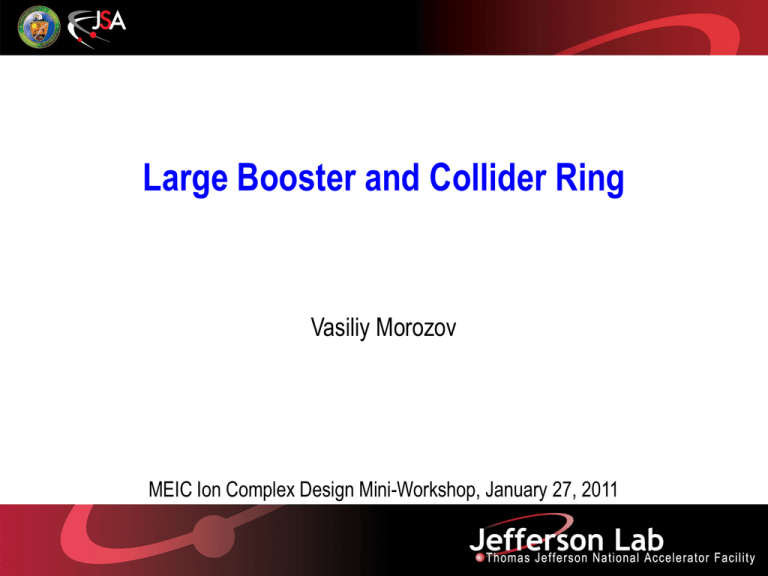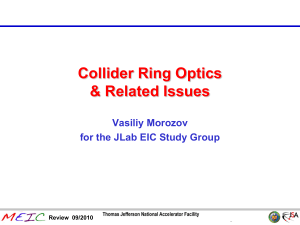Large Booster and Collider Ring
advertisement

Large Booster and Collider Ring Vasiliy Morozov MEIC Ion Complex Design Mini-Workshop, January 27, 2011 MEIC Layout Prebooster 0.2 GeV/c 3-5 GeV/c protons Big booster 3-5 GeV/c up to 20 GeV/c protons 3 Figure-8 rings stacked vertically Big Booster • Acceleration of protons from 3-5 GeV/c to up to 20 GeV/c for injection into ion collider ring • Big booster implementation options – Separate warm ring in collider rings’ tunnel (current baseline) – Using the electron ring – Separate cold ring in the prebooster’s tunnel • Big booster design considerations – Avoid transition energy crossing – Space charge higher injection energy for larger ring – Matching RF systems debunch low-frequency beam and then rebunch it at higher frequency? Figure-8 Collider Rings • Geometrical matching of electron and ion rings – Spin rotators in the electron ring – Siberian snakes in the proton ring arcs Ion Ring IP Potential IP IP Siberian snake Siberian snake Electron Ring RF Spin rotators IP IP Potential IP Spin rotators RF Modular Design Concept • Design separately and incorporate/match into the ring – – – – – – Vertical chicanes for stacking the ion ring arcs on top of the electron ring Injection section Electron cooling section Siberian snakes Interaction region with horizontal crossing Section for local chromaticity compensation Full-Acceptance Detector Proton Electron Beam energy GeV 60 5 Collision frequency GHz 1.5 1.5 Particles per bunch 1010 0.416 1.25 Beam Current A 1 3 Polarization % > 70 ~ 80 Energy spread 10-4 ~3 7.1 RMS bunch length cm 1 0.75 Horizontal emittance, normalized µm rad 0.35 53.5 Vertical emittance, normalized µm rad 0.07 10.7 Horizontal β* cm 10 10 Vertical β* cm 2 2 Vertical beam-beam tune shift 0.007 0.03 Laslett tune shift 0.07 Very small 7 3.5 Distance from IP to 1st FF quad Luminosity per IP, 1033 m cm-2s-1 5.6 IR Design Challenges • Low * is essential to MEIC’s high-luminosity concept • Large size of extended beam f * = F2 – Chromatic tune spread limited momentum aperture – Chromatic beam smear at IP F ~ Fp/p >> * limited luminosity – Sextupole compensation of chromatic effects limited dynamic aperture compensation of non-linear field effects – High sensitivity to position and field errors Compensation of 2nd-Order Terms • Consider parallel beam after extension, u describes the dominant (cos-like) parallel component of the trajectory while is associated with the small remaining angular spread (sin-like trajectory), then, neglecting the angular divergence, one can approximate x1 axu x , y1 a y u y to obtain 1 x u x [(2 Dns n)qaxu x D ( Dns n)q 2 ns (a x2u x2 a y2u y2 )]ds u x 0 2 1 y u y [(2 Dns n)qa y u y 2ns axu x a y u y ]ds u y 0 2 • In order to have x2 0, y2 0 the following conditions must be satisfied 0 0 0 0 2 Dns u x2 ds nu x2 ds, 2 Dns u y2 ds nu y2 ds, D( Dn s 0 n)u x ds 0, n u ds 0, n u u ds 0 3 s x 0 s x 0 2 y Symmetry Concept • Modular approach: IR designed independently to be later integrated into ring • Dedicated Chromaticity Compensation Blocks symmetric around IP • Each CCB is designed to satisfy the following symmetry conditions – – – – ux is anti-symmetric with respect to the center of the CCB uy is symmetric D is symmetric n and ns are symmetric Compensation of Main 2nd-Order Terms • 2nd-oder dispersion term and sextupole beam smear due to betatron beam size D(Dns n)ux ds 0, 3 n u s x ds 0, 2 n u u ds 0 s x y 0 0 0 are automatically compensated. • Chromatic terms 2 Dn u ds nu ds, 2 Dnsu ds nu y2ds 2 s x 0 2 x 0 2 y 0 0 are compensated using sextupoles located in CCB’s attaining – local chromaticity compensation including contributions of both the final focusing quadrupoles and the whole ring – simultaneous (due to symmetry around IP) compensation of chromatic and sextupole beam smear at IP restoring luminosity Ion Collider Ring Geometry with IR (I) • CCB’s on the opposite sides of IP bend the same way IP IP Ion Collider Ring Geometry with IR (II) • CCB’s on the opposite sides of IP bend in the opposite directions – Simpler matching with electron IR’s, which have smaller bending IP IP IP IP Ion Collider Ring Geometry with IR (III) IP IP IP 50 IP Basic Ring Parameters Proton beam momentum GeV/c 60 Circumference m 1353.75 Arc’s net bend deg 230 Straights’ crossing angle deg 50 Arc length m 381 Arc average radius m 95 Straight section length m 295.9 Lattice basic cell Arc FODO cell length Nominal phase advance per cell x / y Total number of arc FODO cells Dispersion suppression FODO m 9 deg 60 / 60 56 Adjusting quad strengths Magnet Parameters Proton beam momentum GeV/c Number of arc dipoles 60 144 Dipole length m 3 Bending radius m 53.8 Bending angle deg 3.2 T 3.7 Bending field at 60 GeV/c Number of quads Quad length 364 m 0.5 Quad strength in arc FODO cells T/m 92 Maximum quadrupole strength T/m 180 Maximum sextupole strength T/m2 519 Arc FODO Cell • /3 betatron phase advance in both planes • Magnet parameters for 60 GeV/c protons: – Dipoles: • • • • length = 3 m bending radius = 53.8 m bending angle = 3.2 bending field = 3.7 T – Quads: • length = 0.5 m • strength = 92 T/m Dispersion Suppressor • 3 arc quads are used to suppress dispersion while keeping -functions from growing • Maximum quad strength at 60 GeV/c = 122 T/m Short Straight for Siberian Snake • • • • Symmetric quad arrangement Initial values from the dispersion suppressor Quads varied to obtain x,y = 0 in the middle at limited max Maximum quad strength at 60 GeV/c = 117 T/m Arc End with Dispersion Suppression • Dispersion suppressed by varying quads with limitations on max and Dmax • Maximum quad strength at 60 GeV/c = 147 T/m To straight section Complete Arc • Length = 381 m, net bend = 230, average radius = 95 m Final Focusing Doublet • Distance from the IP to the first quad = 7 m • Maximum quad strength at 60 GeV/c = 175 T/m x 10 cm y 2 cm Chromaticity Compensation Block • Satisfies the required symmetries for the orbital motion and dispersion • Maximum quad strength at 60 GeV/c = 78 T/m Matching of CCB to Arc • Maximum quad strength at 60 GeV/c = 180 T/m Matching of CCB to Straight • Maximum quad strength at 60 GeV/c = 180 T/m Interaction Region • Total length = 143 m Complete Collider Ring • Total length = 1353.75 m Summary of Optics Parameters Proton beam momentum GeV/c 60 Circumference m 1353.75 Arc’s net bend deg 230 Straights’ crossing angle deg 50 Arc length m 381 Straight section length m 295.9 Maximum horizontal / vertical functions m 1952 / 2450 Maximum horizontal dispersion Dx m 1.7 Horizontal / vertical betatron tunes x,y 24.(34) / 20. (59) -590 / -812 Horizontal / vertical chromaticitiesx,y Momentum compaction factor 5.5 10-3 Transition energy tr Horizontal / vertical normalized emittance x,y At 20 GeV/c injection: Maximum horizontal / vertical rms beam size x,y At 60 GeV/c: Maximum horizontal / vertical rms beam size x,y 13.4 µm rad 0.35 / 0.07 mm 19 / 21 mm 3.3 / 1.6 Chromatic Tune Dependence • No compensation Chromaticity Compensation • Two pairs of sextupoles placed symmetrically in each CCB • Maximum sextupole strength at 60 GeV/c = 519 T/m2 Chromatic Tune Dependence Before compensation After compensation







